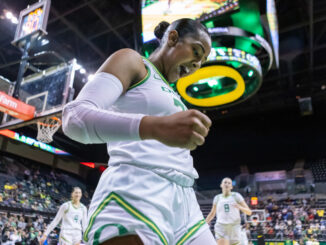
In nature, beavers and ducks occupy similar spaces. One chews down trees and builds dams; the other does the whole, smooth on top, crazy down below thing.
In sports, it’s a different matter—at least in Oregon. The University of Oregon Ducks and the Oregon State University Beavers battle fiercely, any chance they get.
There’s even a term for it: the Civil War. “Civil” as in a reflection of the otherwise peaceful, polite reputation of Oregonians; “War” as in a conflict involving a level of animosity more commonly associated with Antietam and Gettysburg than Eugene and Corvallis.
The rivalry spans many sports. Currently, it’s manifesting itself most competitively in women’s basketball. There’s plenty at stake, and not just local bragging rights. The Ducks and the Beavers are battling for the top of the conference and seeding in the NCAA Women’s Basketball Tournament, which both teams are destined to play in.
First off, the two regular-season matchups between the programs just took place in the last week. Last Friday, Oregon defeated Oregon State in Eugene, 77-68. Then, on Monday, the Beavers returned the favor by drowning the Ducks (sorry) in Corvallis, 67-62, which was a nail biter of a game right down to the last possession.
The bottom line is that both teams are very good and competitive, not just with one another, but on the national stage. Oregon started this week ranked second in the country; it was the program’s highest ever national ranking. Oregon State entered the week ranked 12th in the sport. Given that these rankings came in the middle of their weekend double-header, you might expect Oregon to fall a spot or two and Oregon State to rise a spot or two when next week’s rankings come out. Either way, they are both very good, top 10-ish teams, with perhaps Oregon having the slight edge at this time.
What has Oregon accomplished thus far in the season, in addition to their lofty rankings in the AP Top 25 Poll? Well, until Monday’s loss at Gill Coliseum, they had been riding a magic carpet-like, 17-game winning streak. They are still solidly in first place in the Pac-12 Conference, and, barring any more slip-ups, they should expect to be in first place when the regular season ends in a few weeks. They currently sit at 24-2 overall and 13-1 in conference. I’m sure right now they’re wishing those Beavers would crawl down into their dam and never come back up, though it’s conceivable and perhaps likely that they will face each other at least one more time in the Pac-12 Tournament.
Potential pitfalls include the Ducks’ final two games of the season: 3/1 at Arizona and 3/3 at Arizona State. Both schools are excellent themselves and should provide stiff challenges and have plenty of reason to finish the season with a bang and head into tournament with some mojo of their own.
Another challenge is the loss of key starter Ruthy Hebard to injury in Monday’s game against Oregon State. It sounds like it’s a soft tissue issue in her knee, and her participation in the next couple of games is questionable. Hebard shoots 69 percent from the floor and is averaging better than 16 points per game, so her loss will likely be more than a little noticeable.
Should they be able to overcome this injury and win out, the Ducks should expect to win the conference, be the number one overall seed in the Pac-12 Women’s Basketball Tournament (March 7-10 in Las Vegas), and, depending on their performance there, be seeded as high as one or two in the NCAA Women’s Basketball Tournament (March 22-April 7). Anything short of that, at this point, should be considered a disappointment.
Though Oregon may have an edge this year, it’s Oregon State that has been better for longer, largely due to head coach Scott Rueck, who took over the program in 2010. The team’s breakout season under Rueck was 2013-14, when the Beavers finished tied for second in the conference and went to the NCAA tournament for the first time since 1996. They’ve gone to the Tournament every year since, including to the 2016 Final Four and the Elite Eight last year.
The Beavers’ final games are an almost mirror image of the Ducks, with matchups on 3/1 at Arizona State and at Arizona on 3/3. Obviously, the Beavers’ desired outcome would be to win both of their Grand Canyon State tilts and for the Ducks to drop theirs. That might be just enough for them to trade places in conference, thus handing Oregon State their first conference title since 2016.
However you slice it, the conference is likely in the hands of one of the two state schools, which has been the case for the last four years. The other team lurking in second place in the conference is Stanford, who has the potential to slide into first place should the Ducks falter or the Beavers not be able to close the deal.
There’s still lots of drama and unanswered questions ahead of us. Buckle up for some must-see basketball over the next six weeks. Actual woodland creatures have got nothing on these teams. That much we know for certain.




